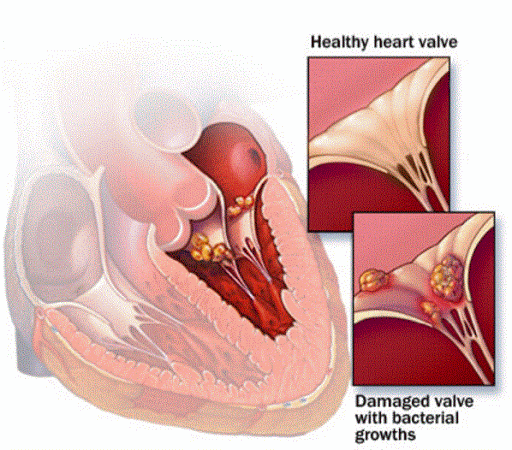Learn about endocarditis
Posted by Dr. Dao Thi Mai Lan - Vinmec Institute of Stem Cell and Gene Technology
Endocarditis is a disease that can lead to life-threatening conditions. A stroke or reduced blood flow to organs can occur when clumps of bacteria break off and block a blood vessel. Therefore, it is necessary to have accurate diagnosis and timely treatment.
1. What is endocarditis?
Endocarditis is an infection of the inner lining of the heart and its valves. Infections caused by bacteria or fungi that enter the bloodstream through the lining of the mouth, open wounds, or needles. Infection can also occur from medical procedures from an infected incision.
Normally, bacteria that enter the bloodstream pass through the heart and are not harmful thanks to the protection of the immune system. However, bacteria circulating in the bloodstream can attach to heart tissue that is already damaged by certain heart conditions or artificial heart valves. Bacteria can hide from the immune system and cause dangerous infections.
Endocarditis can lead to life-threatening conditions. A stroke or reduced blood flow to organs can occur when clumps of bacteria break off and block a blood vessel. The bacteria that cause endocarditis can also spread to other organs, damaging tissues. Uncontrolled endocarditis can permanently damage heart valves, eventually leading to heart failure.
Normally, bacteria that enter the bloodstream pass through the heart and are not harmful thanks to the protection of the immune system. However, bacteria circulating in the bloodstream can attach to heart tissue that is already damaged by certain heart conditions or artificial heart valves. Bacteria can hide from the immune system and cause dangerous infections.
Endocarditis can lead to life-threatening conditions. A stroke or reduced blood flow to organs can occur when clumps of bacteria break off and block a blood vessel. The bacteria that cause endocarditis can also spread to other organs, damaging tissues. Uncontrolled endocarditis can permanently damage heart valves, eventually leading to heart failure.

Viêm nội tâm mạc là tình trạng nhiễm trùng ở màng trong của tim và các van tim
2. Causes of endocarditis
Endocarditis is caused by bacteria or fungi that enter the bloodstream from outside the body. People with healthy hearts are less likely to develop endocarditis. Certain heart diseases and certain procedures used to treat certain types of heart disease make them more susceptible to endocarditis, including:
Congenital heart disease Heart valve disease Hypertrophic cardiomyopathy Valve replacement prosthetic heart Implants of assistive devices, such as pacemakers, patients with a history of endocarditis are more susceptible to other heart infections. People with weakened immune systems (for example, HIV infection or organ transplants) are also more likely to develop heart infections.
Congenital heart disease Heart valve disease Hypertrophic cardiomyopathy Valve replacement prosthetic heart Implants of assistive devices, such as pacemakers, patients with a history of endocarditis are more susceptible to other heart infections. People with weakened immune systems (for example, HIV infection or organ transplants) are also more likely to develop heart infections.
3. Symptoms of endocarditis
Symptoms of endocarditis are similar to those of the flu or other viral infections and include: Fever, chills, night sweats, lack of energy, weakness, paleness, joint pain and muscle
Other symptoms may include:
Bleeding areas under fingernails and toenails (thin hemorrhages) Painless, red spots on palms and soles (Janeway lesions) ) Red, painful nodules on the pads of the fingers and toes (Osler's nodes) Small purple or red spots on the skin, whites of the eyes, or in the mouth Difficulty breathing Persistent cough Unexplained weight loss Swelling of the feet , lower leg, or abdomen Symptoms of endocarditis can develop quickly (within days) or slowly (over several weeks).
Other symptoms may include:
Bleeding areas under fingernails and toenails (thin hemorrhages) Painless, red spots on palms and soles (Janeway lesions) ) Red, painful nodules on the pads of the fingers and toes (Osler's nodes) Small purple or red spots on the skin, whites of the eyes, or in the mouth Difficulty breathing Persistent cough Unexplained weight loss Swelling of the feet , lower leg, or abdomen Symptoms of endocarditis can develop quickly (within days) or slowly (over several weeks).

Bệnh nhân đã từng bị viêm nội tâm mạc một lần dễ bị các nhiễm trùng tim khác
4. Diagnosis of endocarditis
Tests commonly used to diagnose endocarditis include:
Blood tests: A blood culture is done to determine the type of bacteria or fungus causing the infection. Different types of infections require different treatments. A complete blood count is also done to look for damage to the blood cells. When endocarditis is suspected, blood cultures should be obtained prior to antibiotic administration. These drugs can mask the presence of infectious microorganisms in the blood. Echocardiogram : To check the condition of the heart valves and blood vessels in the heart Electrocardiogram (ECG): To identify possible heart rhythm problems due to infection Chest X-ray, computed tomography (CT), or magnetic resonance imaging (MRI): to look for physical damage to the heart or other organs.
Blood tests: A blood culture is done to determine the type of bacteria or fungus causing the infection. Different types of infections require different treatments. A complete blood count is also done to look for damage to the blood cells. When endocarditis is suspected, blood cultures should be obtained prior to antibiotic administration. These drugs can mask the presence of infectious microorganisms in the blood. Echocardiogram : To check the condition of the heart valves and blood vessels in the heart Electrocardiogram (ECG): To identify possible heart rhythm problems due to infection Chest X-ray, computed tomography (CT), or magnetic resonance imaging (MRI): to look for physical damage to the heart or other organs.
5. Treatment of endocarditis
5.1. Drug treatment
Treat endocarditis with very high doses of antibiotics or antifungals. The drug is given directly into the venous blood through an intravenous (IV) line. The drug is usually taken continuously for about 6 weeks. Drug treatment for endocarditis begins in the hospital, but some patients can complete IV treatment at home. Fungal infections are more difficult to treat with medication than bacterial infections.
5.2. Surgery
Sometimes surgery is needed to remove damaged tissue or infected areas. Surgery may also be needed to repair or replace heart valves damaged by endocarditis.

Điều trị viêm nội tâm mạc bằng liều kháng sinh rất cao hoặc thuốc chống nấm
6. Risk factors and precautions
Patients at high risk for endocarditis should have good oral hygiene, including regular brushing, flossing, and dental visits. Bacteria that cause endocarditis often enter the bloodstream even though tissues in the mouth are damaged by poor oral hygiene (gingivitis).
Patients at high risk for endocarditis should also avoid cosmetic procedures or tattoos, piercings, as bacteria can pass through the skin into the bloodstream. High-risk patients should also see a doctor if a normal wound does not heal quickly.
Finally, patients at high risk for endocarditis may be prescribed prophylactic antibiotics before certain medical procedures, including dental procedures involving gums, or a number of surgeries.
To protect their own health and prevent complications of endocarditis, patients need to go to a reputable hospital to conduct examination and treatment as soon as signs of the disease appear. Currently, Cardiovascular Center - Vinmec International General Hospital is one of the leading centers in the country for examination, diagnosis, screening and treatment of cardiovascular diseases. With the convergence of a team of experienced and reputable experts in the field of surgery, internal medicine, interventional cardiac catheterization and the application of advanced techniques in the diagnosis and treatment of diseases. Cardiovascular management, along with a system of modern equipment, on par with the most prestigious hospitals in the world such as: 3 Tesla MRI (Siemens), 640 CT machine (Toshiba), other equipment EVIS EXERA III advanced endoscope (Japan Olympiad), Avace high-end anesthesia system, Hybrid operating room according to international standards... The Cardiovascular Center at Vinmec International General Hospital has achieved many successes. work and gain the trust of a large number of patients.
Patients at high risk for endocarditis should also avoid cosmetic procedures or tattoos, piercings, as bacteria can pass through the skin into the bloodstream. High-risk patients should also see a doctor if a normal wound does not heal quickly.
Finally, patients at high risk for endocarditis may be prescribed prophylactic antibiotics before certain medical procedures, including dental procedures involving gums, or a number of surgeries.
To protect their own health and prevent complications of endocarditis, patients need to go to a reputable hospital to conduct examination and treatment as soon as signs of the disease appear. Currently, Cardiovascular Center - Vinmec International General Hospital is one of the leading centers in the country for examination, diagnosis, screening and treatment of cardiovascular diseases. With the convergence of a team of experienced and reputable experts in the field of surgery, internal medicine, interventional cardiac catheterization and the application of advanced techniques in the diagnosis and treatment of diseases. Cardiovascular management, along with a system of modern equipment, on par with the most prestigious hospitals in the world such as: 3 Tesla MRI (Siemens), 640 CT machine (Toshiba), other equipment EVIS EXERA III advanced endoscope (Japan Olympiad), Avace high-end anesthesia system, Hybrid operating room according to international standards... The Cardiovascular Center at Vinmec International General Hospital has achieved many successes. work and gain the trust of a large number of patients.
Để đặt lịch khám tại viện, Quý khách vui lòng bấm số HOTLINE hoặc đặt lịch trực tiếp TẠI ĐÂY. Tải và đặt lịch khám tự động trên ứng dụng MyVinmec để quản lý, theo dõi lịch và đặt hẹn mọi lúc mọi nơi ngay trên ứng dụng.






